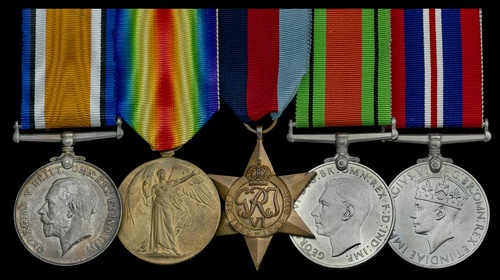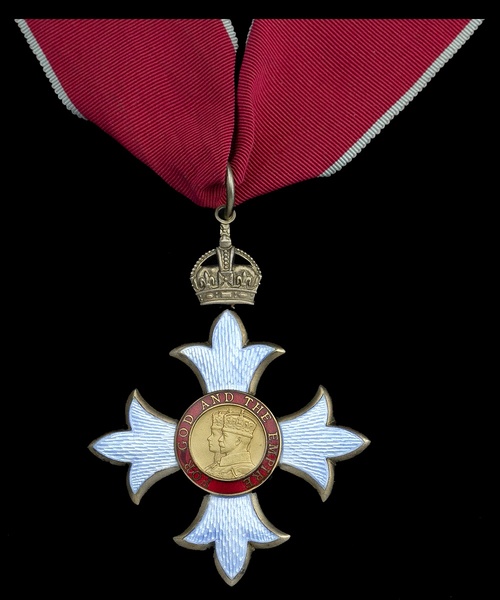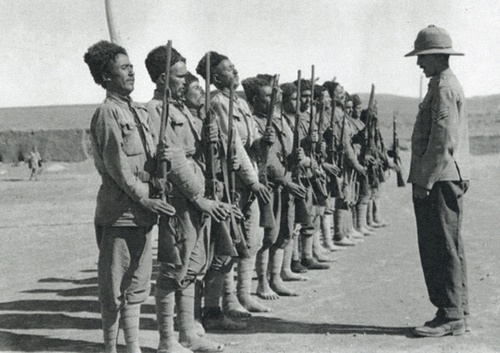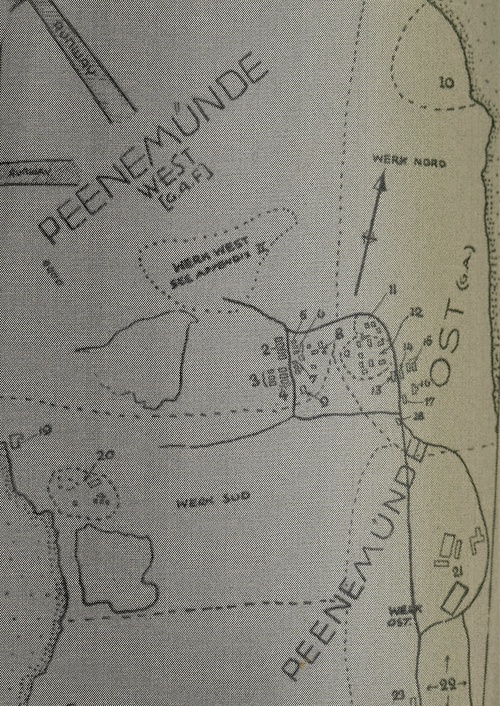Auction: 18003 - Orders, Decorations and Medals
Lot: 590
A rare and interesting 'spook's' C.B.E. group of six to Lieutenant-Colonel L. E. A. Parkin, Indo-European Telegraphic Department and Army Intelligence Corps
A communications expert of prodigious talent, he lent valuable service to 'Dunsterforce' during the operations around Baku in 1918 and, above all, as a senior Intelligence Officer at Latimer House, the famous Second World War M.I. 5 and M.I. 6 interrogation centre, where the conversations of high-ranking German officers - including Hess - were bugged and deciphered
After the war, Parkin became 'Special Adviser' on Telecommunications to the British High Commissioner of Germany. He lived in Cologne for many years and was a tireless ambassador for British industries in Germany, especially Cable and Wireless Ltd.
The Most Excellent Order of the British Empire (C.B.E.), Civil Division, Commander's 2nd type breast badge, silver-gilt and enamel; British War and Victory Medals 1914-1918 (L. E. A. Parkin. I.E. Tel. Dept.); 1939-45 Star; Defence and War Medals 1939-45, generally good very fine (6)
C.B.E. London Gazette 1 January 1960.
Leslie Edwin Albert Parkin was born at Gayton, near Ross-on-Wye, Herefordshire, in 1893. Educated at Gloucester Grammar School, he served with the Indo-European Telegraphic Department (I.E.T.D.) from 1917, with the rank of 2nd Lieutenant. Here, then, an early introduction to the world of 'spooks'.
The I.E.T.D. was a branch of the British Government of India based in London. It provided an international telegraph service that traversed Central Asia, with 33 stations and 2,285 miles of wire by 1907. It rendered invaluable service in the 'Great Game' between Britain and Russia for control of Afghanistan and the buffer states, informing Whitehall of Russian intentions and movements on the North-West Frontier. I.E.T.D. operatives were seconded to boundary commissions, as royalties had to be paid to the authorities across whose land telegraph wires were laid. Far more than simply telegraphists, I.E.T.D. employees were de facto political officers.
Dunsterforce
Parkin served with the I.E.T.D. in Iran from late 1917, operating the Tehran-Mašhad telegraph line. Under the 1907 Anglo-Russian Convention, Russia's sphere of influence extended across the north of Iran from Tabriz to Neyshabur. Russian armies in the region collapsed in the aftermath of the Revolution, leaving a power vacuum into which swept the Ottoman Empire. Turkish forces, with German officers, advanced towards the Caspian Sea in January 1918.
Britain rapidly assembled a task force under General Lionel Dunsterville at Basra on 4 March. Known as 'Dunsterforce', it comprised just 350 officers and N.C.O.s drawn from Australian, New Zealand, British and Canadian forces in Egypt and Mesopotamia. Parkin joined Dunsterforce at Baghdad that April, his role being to maintain communications by training native auxiliaries in the use of telegraph.
In early July an Ottoman army captured Urmia in north-west Iran, displacing 80,000 Assyrians. Dunsterforce managed to turn back the Ottoman pursuit, forming a combined infantry and cavalry brigade from Assyrian volunteers. When a 14,000-strong Ottoman force surrounded the Russian port of Baku on the Caspian Sea on 29 July, its Bolshevik garrison fled in panic. Dunsterforce rushed to the port's defence, covering the 220 miles from Hamadan to Baku in 500 Ford armoured cars. The Allies were desperate to prevent their war matériel falling into enemy hands.
Every spare man in Dunsterforce was engaged in training the Armenians and Russians at Baku; this scratch force had to defend an 18-mile perimeter across the Baku peninsula. Parkin was present at the Battle of Baku from 26 August to 14 September. When the Ottomans moved against Dirty Volcano, a strongpoint on the perimeter, British Empire troops repulsed their attacks four times while the local troops melted away. A Canadian Captain commanding an Armenian brigade suddenly found himself fighting alone. The crew of a Bolshevik ship informed Dunsterville:
'We have witnessed with intense admiration the heroic conduct of your brave British soldiers in the defence of Baku. We have seen them suffering wounds and death bravely in defence of our town, which our own people were too feeble to defend.'
By 12 September the Ottomans were able to bombard the port with observed artillery-fire, and Dunsterforce was evacuated during the night of 14-15 September in two ships. The Ottoman bombardment continued throughout the night, and by dawn around 6,000 Armenian civilians had been killed. Dunsterforce regrouped at Bandar-e Anzali in Iran on 18 October.
Following Allied victories at Dobro Pole near Salonika on 18 September, and at Megiddo in Palestine on 25 September, Turkish forces in Iran were compelled to withdraw and protect their homeland. Dunsterforce then took on a humanitarian role, delivering supplies to famine-affected areas and resettling displaced populations. Major-General W. M. Thomson succeeded Dunsterville on 17 September; the force was renamed 'Norperforce' after its operational area, North Persia. Norperforce, assisted by the White Russian Bicherakov Cossacks, re-entered Baku on 17 November. By then, the Ottoman Empire had already surrendered. Sir William Raine Marshall's victory over the Turkish 6th Army at the Battle of Sharqat, near Mosul, led to the Armistice of Mudros on 30 October.
Parkin remained in Mesopotamia until 23 July 1922, when he started a civilian job with the Indo-European Telegraph Company in Warsaw.
Latimer House
The resumption of hostilities with Germany saw Parkin commissioned as a 2nd Lieutenant in the Intelligence Corps on 27 December 1939. From August 1942 he was stationed at Latimer House in Buckinghamshire, an Elizabethan manor which masqueraded as 'No. 1 Distribution Centre' but was known - in M.I.5 and M.I.6 circles - as the 'Combined Services Detailed Interrogation Unit' (C.S.D.I.U.). Thousands of German prisoners, including Hitler's generals, passed through Latimer and had their conversations bugged. Rudolf Hess, Hitler's Deputy, was held at Latimer in 1942 after his Messerschmitt 110 crashed in Scotland on 10 May 1941 (see Fry 2014, 372 f.).
Parkin's name appears on the roll of Intelligence Officers employed as interrogators at Latimer (WO 208/4970). Headed by Colonel Thomas Joseph Kendrick, a senior member of M.I. 6, Parkin and his colleagues evolved ingenious methods of extracting information from PoWs. When the PoWs arrived, the interrogators took them along The King's Walk, a delightful tree-lined avenue which Charles I is reputed to have enjoyed. Each tree concealed a bugging device. The interrogators, disguised as regular 'guards', would draw the PoWs towards the trees, subtly threading war-related topics into seemingly innocuous conversations. The Germans never suspected that these conversations were being monitored. Latimer's hidden microphones even recorded them saying: 'The British are too stupid to bug our conversations.'
Latimer's greatest triumph was the discovery of the V1 and V2 weapons programme. While interviewing PoWs the interrogators would feign ignorance, pulling out fanciful drawings of the weapons according to the latest British 'intelligence'. This gave the PoWs a false sense of security, and when they returned to their bugged rooms they would carelessly divulge everything they knew. The following conversation between two PoWs (WO 208/4162) was recorded just after an interrogation on 11 March 1943:
'A77: I was very amused yesterday when they [interrogation officers] showed me a drawing of the sloping ramp rocket projector.
M11: That doesn't convey anything at all. I've no idea how big it really is.
A77: The track along which the projectile travels was tiny, just as the projectile was. You know these heavy trench mortars, these grenades with a long wing (??)… a projectile just like that! How I laughed… I was quite helpless with laughter. The sloping ramp looks similar but… quite different… They know nothing about it, which is a relief to me.'
Several weeks later, PoWs revealed the Baltic village of Peenemünde as the site of V2 development:
'BASSENGE: This place Peenemünde was begun at a time when I left the technical office and therefore I never went to see it.
NEUFFER: But for what purpose? Hadn't we already got Rechlin?
BASSENGE: Well, Peenemünde was not built by the German Air Force (G.A.F.), but by the army and we had only one section built into it by the G.A.F. which attracted my interest, and that was the rocket business.'
When combined with photographic reconnaissance at R.A.F. Medmenham, these snippets of information enabled Air Intelligence chiefs to build a full picture of the Peenemünde site. On 29 June, after hearing evidence from Professor Lindemann, Churchill authorised an R.A.F. raid on Peenemünde with the words: 'we must bomb by moonlight… we must attack on the heaviest possible scale.' Codenamed Operation "Hydra", the R.A.F. raid on 17/18 August involved 324 Lancasters, 218 Halifaxes and 54 Stirlings. At the cost of 215 British airmen killed, Hitler's rocket test launches were delayed by at least seven weeks (Fry 2014, 394). At a meeting of the Joint Intelligence Sub Committee on 15 February 1945, the chiefs reported that the work of Kendrick's unit was 'one of the most valuable sources of intelligence on [German] rockets, flying bombs, jet propelled aircraft and submarines.'
PoWs at Latimer were treated extremely well, with interrogators taking them on trips to London. Shopping at Harrods and lunch at Simpsons on the Strand were far more effective means of extracting information than forced interviews or torture. When they saw that life in London was continuing as normal, the PoWs lost faith in Goebbels' propaganda about London being 'flattened'. By extension they lost faith in Hitler, in many cases turning against the Nazi regime. St. Clare Grondona, Kendrick's colleague at M.I. 6, stated that without Latimer's interrogators 'it could have been London and not Hiroshima which was devastated by the first atomic bomb.'
From 1947 to 1955, Parkin worked as 'Special Adviser' on Telecommunications to the British High Commissioner of Germany. He remained in Germany as a Representative of the Federation of British Industries, promoting the expansion of Cable and Wireless Ltd. For these services he was awarded the C.B.E. (Civil) in the 1960 New Year's Honours List (London Gazette, 1 January 1960). Six years later he was made an Officer of the Order of Merit of the Federal Republic of Germany. He lived at 219, Gottsteinstrasse, Köln-Marienburg.
In 1949 he married Dorothy Elizabeth Parrot Humphreys, an interpreter at Latimer House. On retirement, Parkin lived at Podger's Orchard, Drayton, Somerset; sold with copied research and MIC.
Recommended reading:
Fry, H., Spymaster: The Secret Life of Kendrick (London, 2014).
Subject to 20% VAT on Buyer’s Premium. For more information please view Terms and Conditions for Buyers.
Sold for
£1,300











